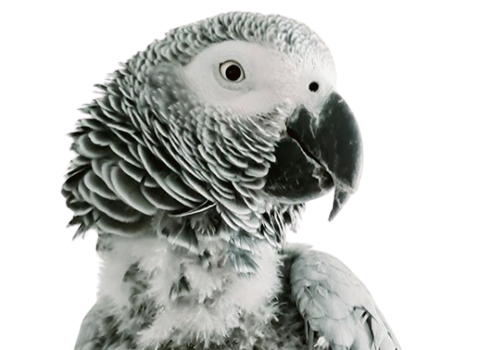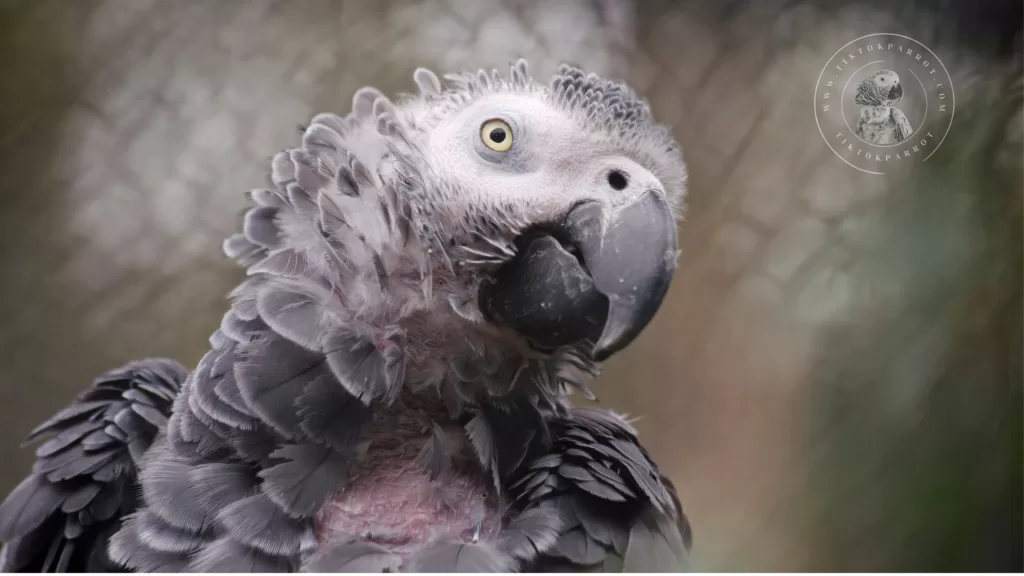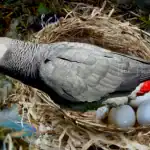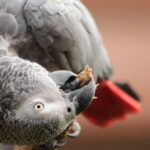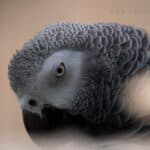The Great Feather Fluff: A Guide to Your African Grey’s Molting Marathon
Hey there, parrot pals and fellow African Grey guardians! Welcome back to TiktokParrot.com, your one-stop shop for navigating the joys (and occasional feather blizzards) of life with a Grey!
Today, we’re diving into the fascinating, and sometimes frustrating, topic of molting.
Conquer the feather storm! Our complete guide unravels the African Grey’s molting mysteries & helps you navigate the (hilarious!) feather fluffing frenzy. Learn when it happens, why it matters, and how to support your parrot during this natural process.
Imagine waking up one morning to find your favorite sweater covered in a light dusting of…well, not exactly glitter. That’s kind of what living with an African Grey during their molt feels like. Feathers. Everywhere. Think of it as a nature-made snowstorm, only instead of snowflakes, it’s tiny, colorful quills raining down on everything you own.
But fear not, feather fanatics! This is a perfectly natural process, and with a little understanding and a good vacuum cleaner, you can survive (and even laugh through!) the molt.
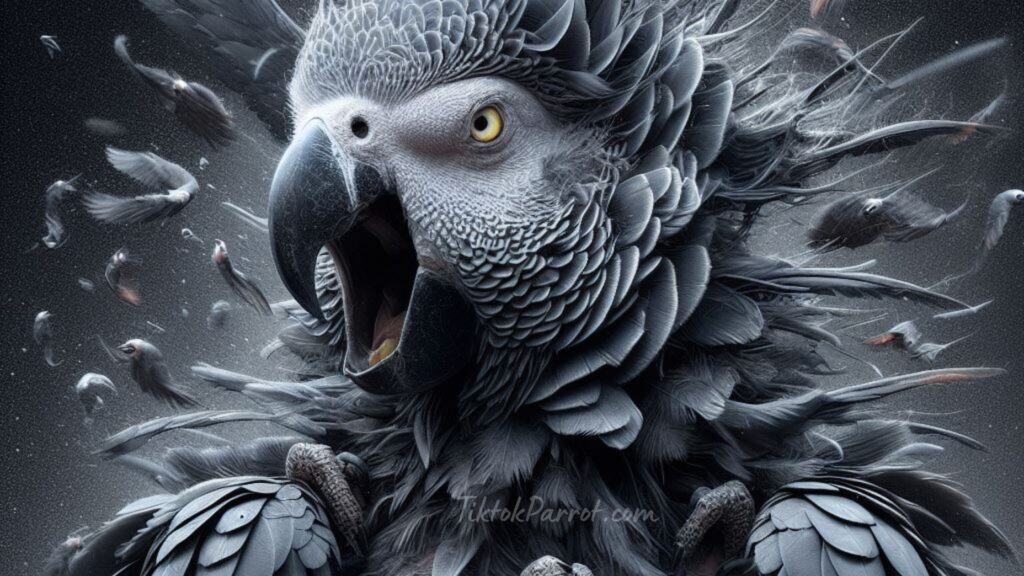
Understanding the Molting Process
Molting is a natural process in which birds shed old or damaged feathers and grow new ones to maintain their plumage’s health and integrity. For African Grey parrots, molting occurs approximately once or twice a year, typically in the late summer or early autumn months. However, the exact timing can vary depending on factors such as the bird’s age, health, diet, and environmental conditions.
Why Do Greys Molt Anyway?
Just like us humans shed our skin cells, African Greys shed their feathers to make way for new, healthy plumage. This annual (or sometimes bi-annual) transformation helps them maintain optimal insulation, waterproofing, and of course, that stunningly sleek, iridescent coat we all admire. Think of it as a wardrobe upgrade for your feathered friend – a chance to ditch the old and embrace the shiny, new feathers!
Molting Mayhem: What to Expect
The molting process can vary in length and intensity depending on your Grey’s age, health, and environment. Here’s a breakdown of what you can expect:
The First Big Shed: Around eight to ten months old, your little Grey will experience their first major molt. This is where they shed those soft, fuzzy downy feathers and start growing in their adult plumage. Imagine a fluffy chick transforming into a sleek, sophisticated adult – complete with a wardrobe malfunction (because let’s be honest, feathers everywhere is never a good look).
The Annual Shuffle: Once your Grey reaches adulthood (around 18 months), they’ll typically molt once or twice a year. This involves shedding feathers throughout their body, with a focus on wing and tail feathers last. Picture it as a slow-motion feather explosion, with your Grey looking slightly ragged around the edges for a few weeks.
How Hard is Molting For an African Grey
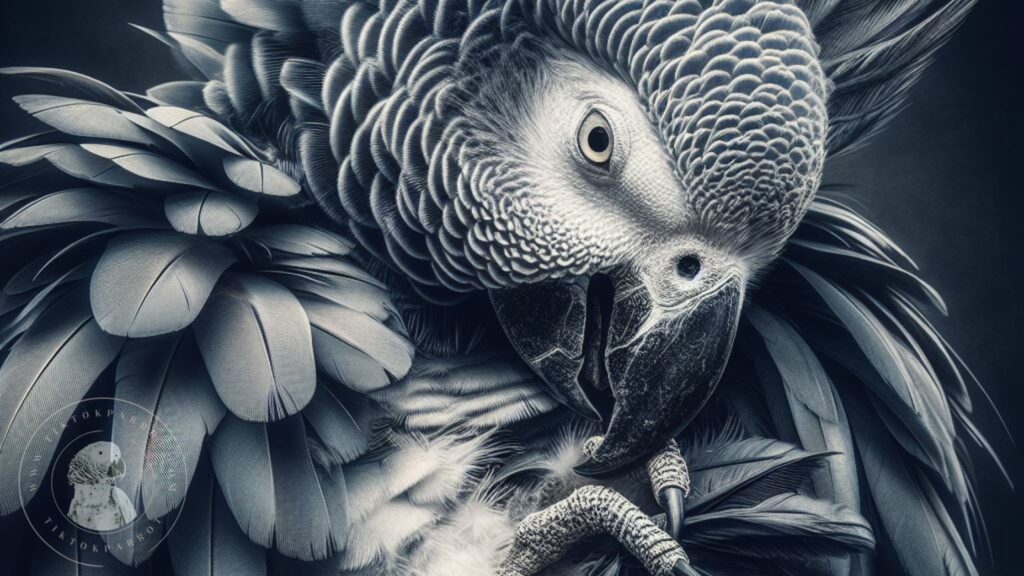
Molting can be a challenging time for African Grey parrots. During molting, which typically occurs once or twice a year, parrots shed old feathers and grow new ones. This process is essential for maintaining their plumage and overall health, but it can also be physically and emotionally taxing for the bird.
One of the main difficulties during molting is discomfort. As old feathers are shed and new ones grow in, parrots may experience itching, irritation, and sensitivity around their skin and feather follicles. This discomfort can lead to increased grooming behaviors, such as excessive preening or scratching, as the bird tries to alleviate the itching sensation.
Additionally, molting can impact a parrot’s energy levels and mood. The physical demands of growing new feathers require a lot of energy, which can leave the bird feeling tired and lethargic. Some African Grey parrots may also become more irritable or sensitive during molting due to hormonal changes and discomfort.
Proper nutrition and environmental conditions are crucial during molting to support the bird’s health and well-being. Providing a balanced diet rich in essential nutrients, such as protein, vitamins, and minerals, can help support feather growth and overall health. Ensuring the bird has access to plenty of clean water and a comfortable environment free from drafts or temperature extremes can also aid in the molting process.
While molting can be a challenging time for African Grey parrots, with proper care and attention from their owners, they can navigate through this period more comfortably and emerge with a healthy, vibrant plumage. In this blog we will also discuss how you can support your bird during this period. Regularly monitoring the bird’s behavior and providing extra TLC during molting can help alleviate some of the difficulties associated with this natural process.
Factors Influencing Molting
Several factors can influence the timing and duration of molting in African Grey parrots. These include:
- Season: Molting often occurs in response to changes in daylight hours and environmental conditions. In the wild, African Grey parrots molt to replace worn feathers and prepare for temperature changes associated with different seasons.
- Hormonal Changes: Hormonal fluctuations play a significant role in triggering molting in birds. As breeding season approaches, African Grey parrots may experience hormonal shifts that stimulate feather regeneration.
- Nutrition: Adequate nutrition is crucial for supporting healthy feather growth and molting. A balanced diet rich in vitamins, minerals, and protein is essential for ensuring that African Grey parrots have the necessary nutrients to grow strong and vibrant feathers.
- Stress Levels: High levels of stress or anxiety can disrupt the molting process in African Grey parrots. It’s essential to provide a calm and stable environment for your bird during this time to minimize stress and promote optimal feather regeneration.
how to tell if your African grey is molting or plucking?
Distinguishing between molting and plucking in African Grey parrots can be important for understanding and addressing their needs. Here are some key differences:
- Feather Appearance:
- Molting: During molting, you’ll notice a gradual shedding of old feathers and the emergence of new ones. Feathers lost during molting typically have a tapered, natural appearance at the ends.
- Plucking: In contrast, plucked feathers often have a blunt, uneven appearance, as they are forcefully removed by the bird rather than falling out naturally.
- Pattern of Feather Loss:
- Molting: Molting typically occurs symmetrically across the bird’s body, with feathers being shed and replaced in a predictable pattern. You may notice feathers being dropped gradually over time.
- Plucking: Plucking tends to result in patchy areas of feather loss, often concentrated in specific regions such as the chest, back, or under the wings. The feather loss may appear sudden and irregular.
- Behavioral Signs:
- Molting: African Grey parrots undergoing molting may exhibit increased preening behaviors as they groom their feathers and alleviate discomfort. However, this grooming is typically focused on maintaining the remaining feathers rather than excessive plucking.
- Plucking: Birds that are plucking their feathers may display repetitive, compulsive behaviors such as pulling at their feathers with their beak or feet. They may also seem agitated or stressed.
- Physical Examination:
- Molting: During molting, you may notice the presence of new pin feathers emerging from the skin, indicating active feather growth. These pin feathers are covered in a protective sheath and gradually unfurl as they mature.
- Plucking: In cases of plucking, you may observe signs of trauma or damage to the skin in areas where feathers have been forcibly removed. This could include redness, inflammation, or even open sores.
If you suspect that your African Grey is plucking rather than molting, it’s essential to identify and address the underlying cause. Possible reasons for plucking behavior include stress, boredom, illness, or environmental factors. Consulting with a veterinarian or avian specialist can help determine the cause of the behavior and develop a suitable treatment plan to promote your bird’s health and well-being.
Signs Your Grey is Molting:
Here are some clues that your feathered friend is going through a molt:
- A Feathery Frenzy: They’ll be preening more than usual, trying to keep those new feathers in tip-top shape.
- The Grumpy Greys: Molting can be itchy and uncomfortable, so your Grey might be a little more grumpy than usual. Think of it as teenage angst with feathers (because let’s face it, teenagers are pretty grumpy too!).
- Less Active and Playful: Growing new feathers takes a lot of energy, so your Grey might be less interested in playtime and acrobatics. Imagine trying to run a marathon while wearing a heavy winter coat – not exactly ideal for peak performance.
Helping Your Grey Through the Molt
While molting is a natural process, there are ways to make it more comfortable for your feathered friend. As a responsible pet owner, you can support your African Grey parrot during the molting process:
- Offer a Balanced Diet: Make sure your Grey is getting plenty of protein and essential nutrients to support healthy feather growth. Think of it as fueling their feather factory. Offer your bird a balanced diet consisting of high-quality pellets, fresh fruits, vegetables, and occasional treats. Foods rich in omega-3 fatty acids, such as flaxseeds and walnuts, can help promote healthy feather growth.
- Provide Adequate Hydration: Ensure that your African Grey has access to clean, fresh water at all times. Hydration is essential for supporting overall health and promoting proper feather development.
- Minimize Stress: Create a calm and comfortable environment for your African Grey parrot by minimizing loud noises, sudden movements, and other potential stressors. Provide plenty of opportunities for mental stimulation and enrichment to keep your bird occupied and engaged.
- Gentle Grooming: During molting, your African Grey may appreciate gentle grooming sessions to help remove loose feathers and alleviate any discomfort. Use a soft brush or grooming tool designed specifically for birds to gently groom your parrot’s feathers.
- Up the Humidity: Dry air can irritate your Grey’s skin during molting. Use a humidifier to keep the air moist and help those itchy pin feathers emerge more easily.
- Shower Power: Regular showers or misting can help loosen dead feathers and soothe your Grey’s itchy skin. Just make sure the water is lukewarm and avoid spraying directly on their face.
- Veterinary Care: If you notice any signs of abnormal molting, such as excessive feather loss, bald patches, or skin irritation, consult with a avian veterinarian promptly. These symptoms could indicate underlying health issues that require medical attention.
- Extra TLC: Molting can be stressful, so shower your Grey with extra love and attention. A gentle head scratch or a cuddle session can go a long way!
For how long Molting can last?
The duration of molting in African Grey parrots can vary depending on factors such as age, health, and environmental conditions. Generally, molting can last anywhere from a few weeks to several months.
For most African Grey parrots, the primary molting period typically lasts between 6 to 12 weeks. During this time, the bird will gradually shed old feathers and grow new ones to replace them. However, some individual feathers may molt at different times throughout the year, leading to a more extended molting process.
Factors that can influence the duration of molting include:
- Age: Younger parrots may molt more frequently as they grow and develop their adult plumage. As they mature, molting may become less frequent but still occurs periodically to replace worn or damaged feathers.
- Health: A healthy African Grey parrot with a balanced diet and proper care may experience a smoother and shorter molting process compared to a bird with underlying health issues or nutritional deficiencies.
- Environmental Conditions: Factors such as temperature, humidity, and daylight hours can influence molting patterns in parrots. Changes in environmental conditions, such as seasonal shifts, may trigger molting or affect its duration.
- Genetics: Individual genetic factors can also play a role in molting patterns and duration. Some parrots may have genetic predispositions that affect the timing and length of their molting cycles.
It’s essential for African Grey parrot owners to monitor their bird’s molting process closely and provide appropriate care and support during this time. As I mentioned above, ensuring a nutritious diet, maintaining a comfortable environment, and minimizing stressors can help facilitate a smooth molting process and promote healthy feather growth.
If you have any concerns about your parrot’s molting behavior or duration, consulting with a veterinarian or avian specialist is recommended for personalized guidance and advice.
The Light at the End of the Feather Tunnel
Remember, the molting period is temporary. Soon, your African Grey will be sporting a beautiful, shiny new coat of feathers. Think of it as a runway reveal for your feathered friend – a chance to show off their stunning new plumage! So breathe easy, clean up those feathers, and celebrate this natural milestone in your Grey’s life.
My Closing Thoughts
I would say understanding the molting process is essential for African Grey parrot owners to ensure the health and well-being of their feathered companions. By providing proper nutrition, a stress-free environment, and attentive care during molting, you can help support your African Grey’s feather regeneration and promote overall health and vitality.
Again, remember to monitor your bird closely during molting season and seek veterinary care if you have any concerns about your parrot’s health. With proper care and attention, you can help your African Grey parrot navigate the molting process smoothly and emerge with a vibrant and beautiful plumage.
Now it’s your turn to share! How do you help your African Grey through their molting period? Have any funny molting stories to share? Leave your tips, tricks, and tales in the comments below.
Also you are welcome to join our pet community, at TiktokParrot community, we’re all about building a vibrant community of pet lovers where you can share your experiences, seek advice, and connect with fellow pet enthusiasts.
If you found this blog helpful, It would be great if you could share it with your family and friends who might find it useful as well.
You might like to read these as well 🙂
What Makes African Greys Aggressive?
What are the behavior problems with African Greys?
Why African Grey Parrot Has Black Tongue
The Joys and Challenges of Adopting an African Grey Parrot
What To Do If Your Parrot Is Choking, something stuck in the throat?
Shaking Your Tailfeathers: An African Grey Self Harming
Top 10 Toys to Keep Your Parrot Entertained and Engaged
The Hidden Dangers of Owning an African Grey Parrot: What You Need to Watch Out For
For more useful content about African grey parrots, you can subscribe my site with your email to get notification upon publishing a new blog, the subscribe box you can see on the right side of this page. Also if you get an alert on your web browser while browsing my site, allow it and that will also give you an alert whenever I publish a new blog. 🙂
Stay safe and much love!


Hey there! 🐾 Looking for top-notch pet supplies or anything on Amazon?
Support our site by shopping on Amazon through our this referral link, it will not cost you extra!
Your purchases on Amazon can help us continue providing valuable content.
Thank you for your support! 🛍️
